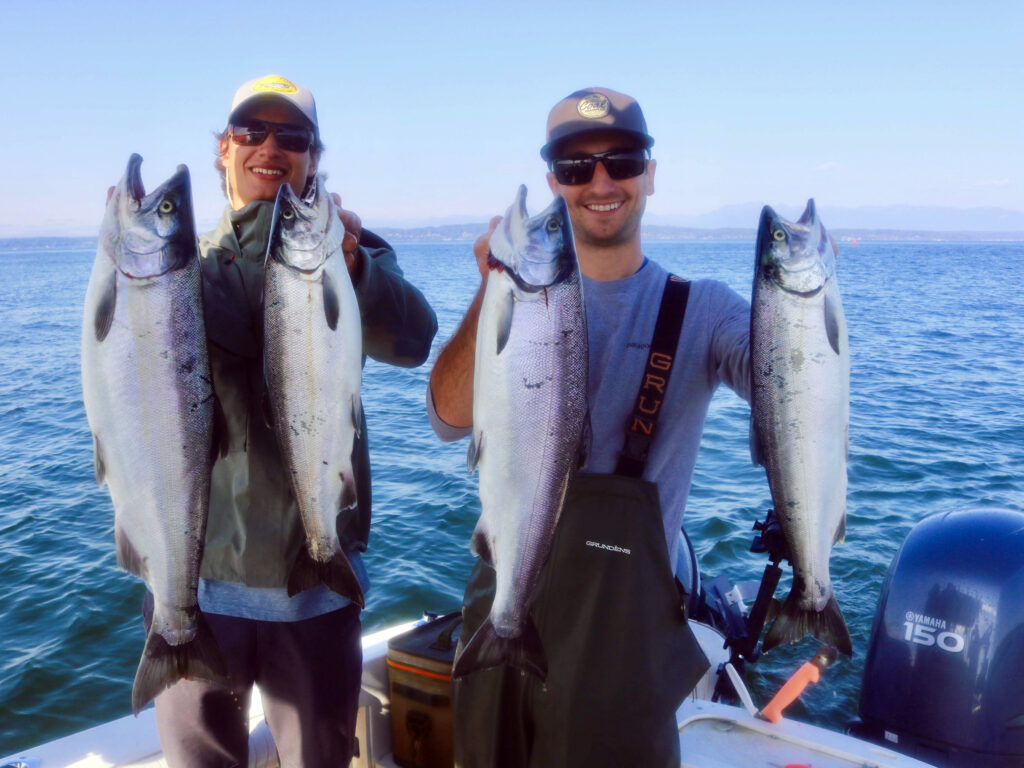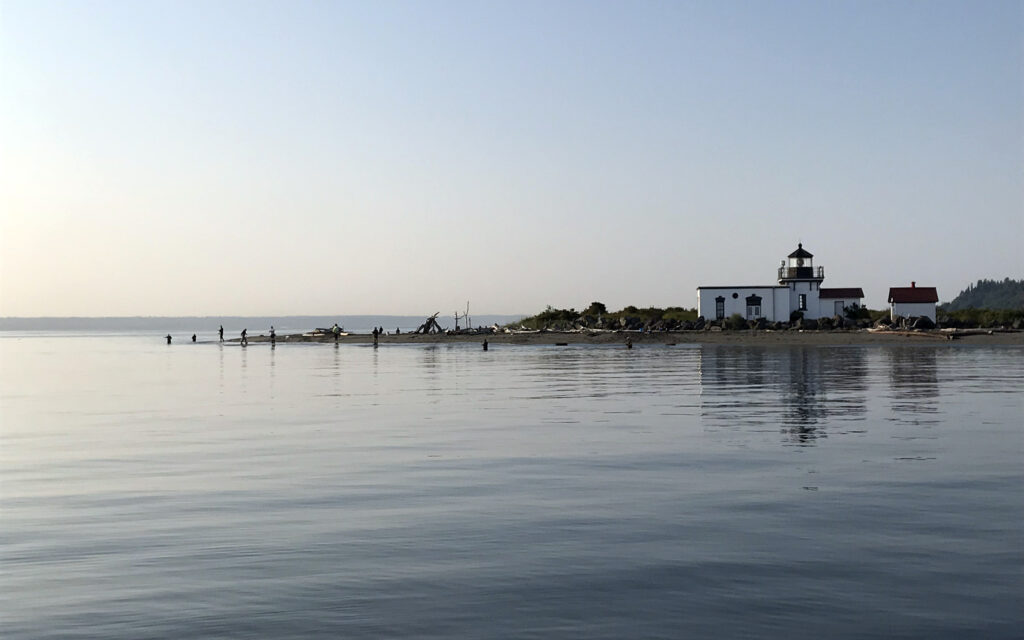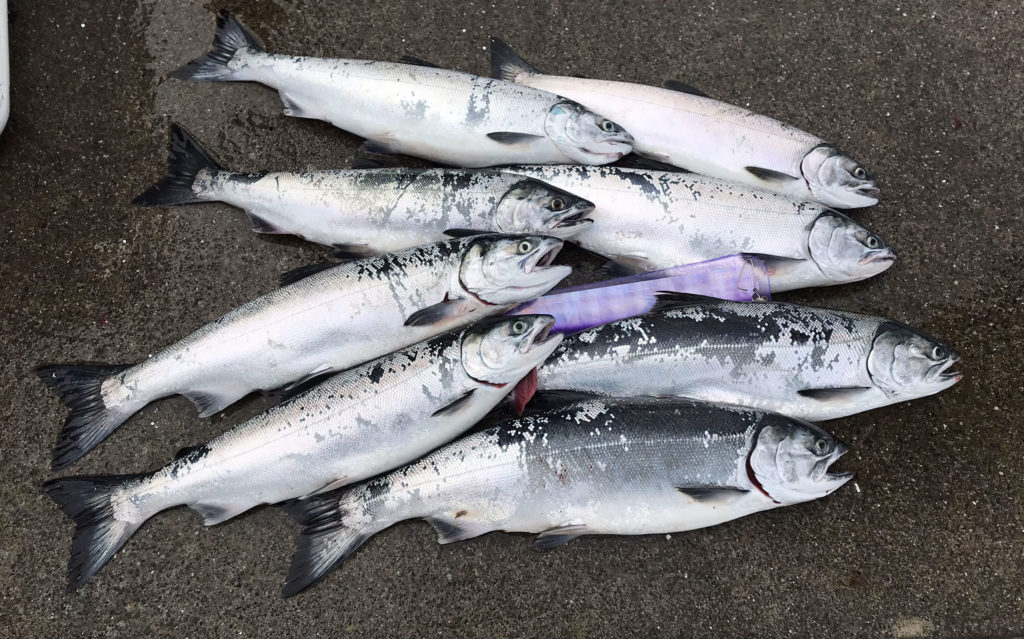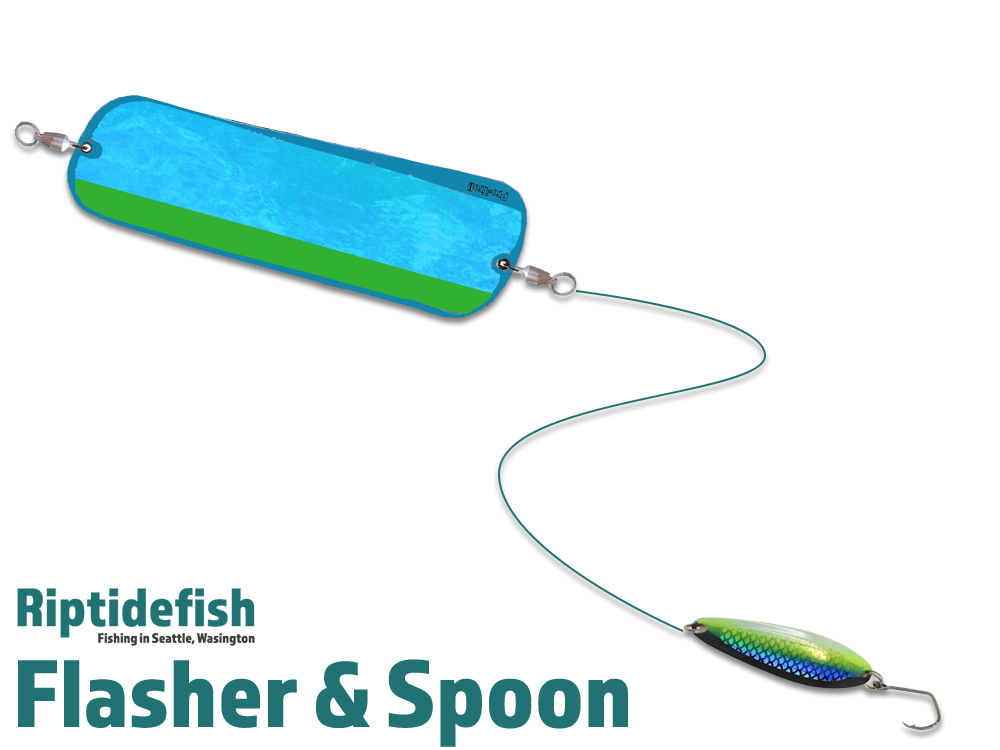The robust fishery for Coho Salmon in Washington’s Puget Sound has captured my attention for many years. As I write this, I fondly think back to my very first saltwater fishing trip. One early September morning, I joined a coworker and his family on his boat to target Coho out of Shilshole Bay near Seattle. We launched before the first glimpse of morning light. I expected a long boat ride and rough seas. I had no idea what was in store for us. But we motored out of the Shilshole Marina breakwater, cruised all of a quarter mile to the Meadow Point green can, and started fishing.
Mack didn’t have downriggers on his boat yet ample confidence that we would do well. We used a handheld spotlight to energize our glow in the dark flashers and lures, tipped each hook with a sliver of salted herring. We let our Deep Six Diver setups out 22 pulls and we were fishing. Our first hookup happened within minutes. The next hour was abuzz with hooking Coho Salmon, avoiding crossed lines, netting fish, resetting gear. We boated eight Coho Salmon within an hour. We had just limited the boat. Ever since fishing that first day on Puget Sound, I have been hooked!
One of Washington’s Best Salmon Fisheries
Puget Sound’s Coho fishery offers up some of the best salmon fishing in Washington State. My goal with this post is to share all of the basics and intricacies that have helped me see great Coho Salmon fishing. Hopefully it helps you have a great day on the water.

When To Fish For Coho Salmon in Puget Sound
Puget Sound has two distinct populations of Coho Salmon. Resident Coho and Ocean Coho. This gives us great fishing from early summer through fall, until the first major weather systems lift our river levels and prompt the salmon to migrate out of Puget Sound, back to their spawning streams.
Puget Sound Resident Coho Salmon
A certain number of natural spawning Coho and a robust hatchery system gives us a Resident Coho Salmon population. These fish live their entire lives in Puget Sound. Some of Puget Sound’s marine areas open for salmon fishing in early summer, usually in June or July. From opening day and onward, we catch these resident fish with pretty good regularity. They are 2-4 pounds at the beginning of the season and grow to 6-8 pounds by the end of the season.

Puget Sound Ocean Coho Salmon
The majority of Puget Sound’s Coho Salmon migrate out to the Pacific as juveniles to feed and mature. They may migrate just outside the entrance and mature in the waters off Neah Bay, Washington or Vancouver Island, British Columbia, or travel farther. The ocean is rich with forage, and they voraciously feed and grow until their biological clock tells them that it’s time to return to the river of their birth. It is during their return trip, when they are at their peak size, that we witness the peak of salmon fishing in Puget Sound. Eventually, they all swim past the beach casters and the trolling fleet and make it to one of Puget Sound’s numerous rivers to spawn.
When the ocean Coho return to Puget Sound, it’s like a tidal wave of good fishing. The peak season is during August and September. When they do return to the Sound, the big mix of resident and ocean Coho give us an amazing couple months. Outlying fishing haunts like Sekiu, Washington and Port Angeles, Washington get the first crack at them. Then they migrate into Central Puget Sound in reach of the Tacoma, Seattle, Edmonds and Everett fishing fleets.
Where To Fish for Puget Sound Coho Salmon
Puget Sound is a vast and complex environment. It has a few large underwater land masses like Possession Bar and Jeff Head that collide with powerful tidal currents, pushing up and concentrating large schools of Herring (and Coho Salmon like Herring). But aside from those areas, Coho will bunch up anywhere that the surface currents converge and create a tide rip. Even if that is in the middle of Puget Sound in the shipping lanes. Regardless of whether you are fishing, on the top of a bank or out in the middle, Coho tend to like the top of the water column.

If you want to familiarize yourself with all the place names mentioned, I have a really thorough post about Chinook fishing with most of these areas mapped. Click here for a map of the Puget Sound salmon fishing hot spots.
How Deep Do I Troll For Puget Sound Coho Salmon?
Regardless of the location I head too, I am usually fishing in over 150′ of water, sometimes it is as deep as 800′. Coho don’t care how deep the water is, but tend to concentrate in the upper part of the water column. If I’m fishing on edges of Jeff Head and the water is 200′ deep, I might fish anywhere from 10′ to 100′ down. If I see a tide rip I like in 800′ of water, it might be 10′ to 150′ down. Early mornings or cloudy days with lower light give us great fishing shallow. As the sun comes up, it’s anyone’s guess! But I usually fish deeper as the sunlight increases.

North Puget Sound Coho Salmon Fishing Spots
Late summer kicks off the return of the first inbound ocean Coho towards Puget Sound. The North Puget Sound boat fleet focuses on the shipping lanes, but also does really well targeting the fish that follow Whidbey Island’s western shoreline. When I target Coho from the beach, I will head to Whidbey’s Bush Point, Lagoon Point, or Fort Casey State Park, where the catching can be great!
- Point Wilson (Fort Worden State Park – Port Townsend)
- Bush Point (West Whidbey Island)
- Lagoon Point (West Whidbey Island)
- Fort Casey State Park (West Whidbey Island)
- Double Bluff (West Whidbey Island)
- Foulweather Bluff (North Kitsap Peninsula)
Central Puget Sound Coho Salmon Fishing Spots
I do most of my summer and early fall fishing in Central Puget Sound. This area offers the greatest abundance of Resident Coho, and sees phenomenal fishing later in the summer when the Ocean Coho arrive. When the Coho are in, most of these areas produce good catches. Easy launching from Seattle, Edmonds, Everett and Kingston.
- Possession Bar (South Whidbey Island)
- Point No Point Shipping Lanes (North Kitsap Peninsula)
- Kingston
- Point Wells and Oil Docks (Edmonds)
- Richmond Beach and Boeing Creek (Shoreline)
- Jeff Head (East of Kitsap Peninsula)
- West Point, Meadow Point and Shilsole Bay (Seattle/Ballard)

South Puget Sound Coho Salmon Fishing Spots
Coho Salmon fishing in Southern Puget Sound can be very good. Most anglers in the South Sound wait until mid-August when the Ocean Coho flood in.
- Allen Bank and Blake Island (North of Vashon Island)
- Redondo (North of Federal Way)
- Point Defiance and Dalco (Tacoma)
- Fox Island (South of Gig Harbor)

Beach Fishing for Coho Salmon in Puget Sound
As Coho Salmon migrate back into Puget Sound, many of them travel very close to shore. This gives the beach fishing crowd a really good chance to bring home a salmon dinner. From the northern reaches of Whidbey Island, to the urban waterfront parks in the City of Seattle, anglers fishing the shoreline catch plenty of Puget Sound Coho Salmon!
The simplest way to catch Coho from the shores of Puget Sound is with a metal jig. Use a 1 ounce to 2 ounce metal jig like a Laser Minnow or Buzz Bomb rigged with a single-point barbless hook, cast it as far as you can, and jig it back to you. Fishing with a herring under a large bobber is also a great option! If you enjoy fly fishing, you absolutely need to get to a beach to try your luck… it can be really good!
Read more: Puget Sound’s Beaches – Salmon Fishing From Shore

Trolling for Coho Salmon in Puget Sound
The trolling fleet catches the majority of Puget Sound Coho. These fish move fast and feed aggressively. They cannot help biting at a fast trolled, erratic bait or lure. You may ask, how fast should I be trolling? I tend to not pay much attention to my boat’s GPS speed-over-ground reading, as I may be trolling with or against the current. But if I had to peg a number, I’d say 2 mph to 4 mph. If you are trolling with a flasher and hoochie or spoon, you want that flasher rotating at a good clip. If you are fishing with a cut-plug herring, you want it spinning fast (although if you are trolling too fast you will rip that bait off the hooks).
How To Perfect Your Trolling Spread
Once I start my troll, I will put the gear in the water and watch it. I’ll adjust my trolling speed to get my flasher/lure or cut-plug herring spinning at a good clip, and deploy to the depth I want to fish. Then I pay close attention to the angle of the downrigger cable at that depth and try to maintain that angle regardless of whether I am trolling with or against the current. This means that I am adjusting my trolling speed to maintain the cable angle. If you are trolling against the current, you will be trolling with a lighter throttle than with it. Wind is another factor, but you get the idea!


Best Puget Sound Trolling Setups for Coho Salmon




Flasher and Hoochie Setup
An 11 inch flasher paired with a 3.5″ Plastic Squid (Hoochie), is my all time favorite setup for Coho trolling in Puget Sound. I like to run a 30-40 pound fluorocarbon leader at 26″-36″ with tandem barbless 4/0 Gamakatsu octopus hooks. Always put a sliver of herring fillet on the upper hook for some scent!

Flasher and Spoon Setup
Some days, Coho get really snappy towards salmon trolling spoons. I like an 11 inch flasher with a 30-40 pound fluorcarbon leader at 30″-40″. You can add scent to the spoon. But be warned! If you add a sliver of herring fillet to the hook it will kill the action of the spoon.

Diver Setup
If you don’t have downriggers but want to troll, using a setup with a deep six diver can help get you down deeper than a sinker. The best divers have a release mechanism built into the design that trips them out of dive mode when the fish hits. This is still a pretty clunky setup. However, we have had some really great days fishing with divers! I run two feet of 40 pound line between the diver and flasher, and 24″ to 36″ leader to my lure. A smaller 8″ flasher will provide action to your lure, and yet not thrash around enough to prematurely trip your diver. Just as with the standard setups listed above, you can replace the flasher with a metal 8″ Salmon Dodger.
Cut Plug Herring Setup
This setup can be trolled behind the boat or used to mooch. It is the simplest and most versatile setup for Puget Sound Coho. I use a 3-4 ounce mooching sinker and a mooching leader (either 2/0-3/0 or 3/0-4/0 on 20-25 pound fluorocarbon). Send it back 25′-30′ and get ready for some ferocious take-downs! For whatever reason, Coho seem to be really curious with the bubbles coming out of your trolling motor’s propwash, and the bait closest to that turbulence will get bit way more than if it is placed anywhere else! Be sure to pre-cut all your baits the night before and put them in a great brine solution to toughen them up for trolling.

Mooching for Coho Salmon in Puget Sound

Mooching is a great option for anyone that doesn’t want to troll. Personally, I love to feel the bite, so holding the rod and actively working a mooching setup is right up my alley. They will often follow the bait right up to the surface before hitting, it’s so cool to see a Coho rocket into sight right next to the boat and attack your bait! I wrote a great overview about Puget Sound Mooching, so please click on the link for more info on mooching.

Get Ready For Some Great Coho Fishing!
Puget Sound’s Coho Salmon returns give us a great way to spend our summer months. It’s time to get your friends and family out for an adventure of your own!










 Labor Day Coho Salmon Fishing – Seattle’s West Point
Labor Day Coho Salmon Fishing – Seattle’s West Point
